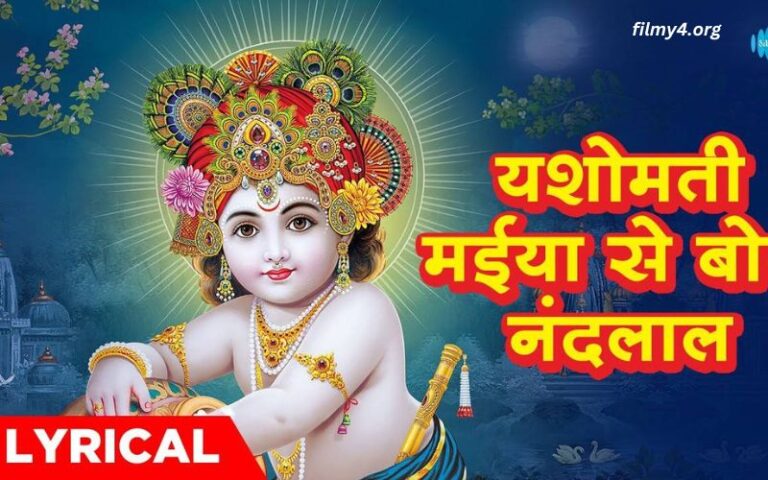The Context of the Song
“Yashomati Maiya Se Bole Nandlala” is a devotional song that depicts a conversation between Lord Krishna, also known as Nandlala, and his mother, Yashoda. The lyrics, penned by the legendary lyricist Pandit Narendra Sharma, are deeply rooted in the lore and traditions of Indian mythology. The song is set in a rural and pastoral backdrop, reflecting the idyllic life of Krishna in the village of Gokul.
The film “Satyam Shivam Sundaram,” directed by Raj Kapoor, explores the themes of beauty, spirituality, and love. While the movie itself received mixed reviews, the soundtrack, composed by Laxmikant-Pyarelal, became a massive hit. Among the many memorable tracks, “Yashomati Maiya Se Bole Nandlala” stands out for its lyrical beauty and Lata Mangeshkar’s emotive singing.
The Lyrics and Their Meaning
The lyrics of “Yashomati Maiya Se Bole Nandlala” are poetic and imbued with deep emotional resonance. The song is a conversation where young Krishna, in his innocent and mischievous manner, questions his mother about the moon. The lyrics are as follows:
css
Yashomati Maiya Se Bole Nandlala
Radha Kyun Gori, Main Kyun KalaRadha Kyun Gori, Main Kyun Kala
Tu Matki Phod De, Ha Ha Ha Ha Ha
Tu Matki Phod De, Ha Ha Ha Ha Ha
Radha Kyun Gori, Main Kyun Kala
The lyrics reveal the innocent curiosity of Krishna, who is puzzled by the difference in skin color between himself and Radha, his beloved. This simple question reflects a deeper philosophical inquiry about identity, love, and the nature of beauty.
The repetitive questioning by Krishna, “Radha Kyun Gori, Main Kyun Kala,” translates to “Why is Radha fair, while I am dark?” This question encapsulates the child-like innocence and the profound nature of Krishna’s inquiries, which often have deeper spiritual meanings in Indian mythology.
Musical Composition
The music for “Yashomati Maiya Se Bole Nandlala” was composed by the iconic duo Laxmikant-Pyarelal. Their composition for this song blends classical Indian musical elements with the simplicity of folk tunes. The melody is soft, gentle, and soothing, perfectly complementing the devotional and pastoral themes of the song.
Lata Mangeshkar’s voice brings a divine quality to the song. Her ability to convey the innocence of Krishna and the maternal affection of Yashoda through her singing is unparalleled. The song’s slow tempo and the use of traditional instruments like the flute and tabla enhance its spiritual ambiance.
Cultural and Spiritual Significance
“Yashomati Maiya Se Bole Nandlala” is more than just a song; it is a reflection of the deep-rooted cultural and spiritual traditions of India. The relationship between Krishna and Yashoda is a popular theme in Indian mythology and literature. Yashoda’s unconditional love and Krishna’s playful innocence are central to many stories and songs.
The song also touches upon the theme of acceptance and self-love. Krishna’s question about his dark complexion is symbolic of the larger societal issues of beauty standards and discrimination. Yashoda’s loving response, which isn’t explicitly detailed in the song but is understood through the context, suggests that love transcends superficial differences.
In many ways, the song is a reminder of the timeless values of love, acceptance, and the purity of a child’s curiosity. It resonates with listeners across generations, reminding them of the simple yet profound truths of life.
Lata Mangeshkar’s Legacy
Lata Mangeshkar’s rendition of “Yashomati Maiya Se Bole Nandlala” is a testament to her unparalleled talent and her ability to bring depth and emotion to every song she sings. Over her illustrious career, Lata Mangeshkar has sung thousands of songs in various languages, but her devotional songs hold a special place in the hearts of her fans.
Her voice has been the soundtrack of the lives of millions, and songs like “Yashomati Maiya Se Bole Nandlala” continue to be cherished. Lata Mangeshkar’s contribution to Indian music is immeasurable, and her legacy continues to inspire new generations of singers and music lovers.
Conclusion
“Yashomati Maiya Se Bole Nandlala” is not just a song; it is an experience, a piece of art that transcends time and space. Its lyrical beauty, soulful composition, and Lata Mangeshkar’s divine voice make it a masterpiece in the realm of Indian devotional music. The song’s enduring popularity is a testament to its universal appeal and the timeless themes it explores.
Through this song, we get a glimpse of the rich cultural tapestry of India, the innocence of childhood, the purity of a mother’s love, and the profound spiritual teachings embedded in simple questions. “Yashomati Maiya Se Bole Nandlala” will continue to be a beloved song, reminding us of the eternal values of love, acceptance, and the joy of seeking answers to life’s simplest yet most profound questions.
